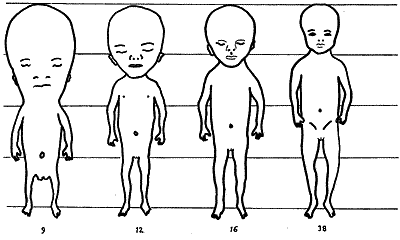
| Diagram illustrating changing proportions of the body during the fetal period. After Keith Moore and T.V.N. Persaud, The Developing Human, 1998, Figure 6-3. |
Carolyn Tate, Ph.D. and Gordon Bendersky, M.D.
|
The human figure as a subject has intrigued sculptors since Paleolithic times. As humans, we are interested in representing the different stages of our bodily development from infancy to corpsehood to skeletonization. In art around the world, individuals have been portrayed with marked physical differences, such as dwarfism and disease.
Similarly, many ontological states are explored in art, ranging from youthful innocence to drunkenness, spiritual ecstasy, painful suffering, sexual arousal, and transformation into an animal or vegetal state. But one aspect of human life has not been widely identified in the corpus of world art: that of the prenatal stage, that is, the fetus. Until now, the earliest known drawing of an accurately defined human fetus was the celebrated one by Leonardo da Vinci, probably dating to the early 16th century, and the earliest known sculpture of the developing human was an 18th century piece intended for medical instruction. My colleague in Philadelphia, Gordon Bendersky, M.D., and I propose that the earliest images of the human fetus were made in Formative Period Mexico more than 2,000 years prior to Leonardo's anatomical study. |
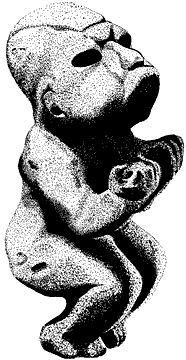
| Fetus effigy with head tilted back and raised arms, of unknown provenance. Stone. Amparo Museum, Puebla. Drawing: G. Bendersky. |
|
This article summarizes our evidence that these sculptures represent the human fetus. It explores the possible significance of the fetus effigies using three lines of investigation. The first situates the fetus as a subject within the corpus of Olmec portable stone sculpture. Next, the archaeological contexts of fetus sculptures and of fetal remains will provide a few clues. Then it considers the attitudes and customs of contemporary Indian groups toward the fetus and maize, to which the fetus is closely related. Finally, I'll reflect upon the LACK of representation of human fetal development in art, a situation which raises questions about Euro-American attitudes toward our own fetal development.
Several years ago, during research for an exhibition of Olmec art, we had the opportunity to examine first-hand hundreds of Olmec sculptures and to study photographs of even more. We realized that there exist over two dozen representations of an unusual and poorly identified anthropomorphic subject. These sculptures have deeply flexed legs and a head-to-body ratio of about 1:3 or 1:4. These proportional ratios are not normal for adult humans, but are for a fetus of 12-30 weeks. Similarly, the flexed-leg convention of the sculptures replicates precisely how the fetus adapts itself to the space of the womb. These characteristics prompted us to explore the possibility that the sculptures might represent fetuses, instead of "dwarfs", "crouching figures," or "dancers" as they had been identified previously. |
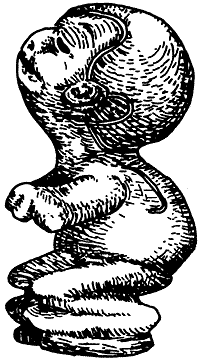
| Fetus effigy with crossed arms, of unknown provenance. Talc; H: 9.3 cm. Dumbarton Oaks Research Library and Collection. Drawing: C. Tate |
|
However, once we had compiled this group of similar sculptures, there was little proof that they indeed represent fetuses. Since the peoples of Formative Period Mexico (1200-400 BC) did not engage in writing, there are no contemporaneous texts that could label or identify these sculptures. In terms of direct evidence for our contention that the sculptures represent fetuses, we are limited to comparative morphology, or as art historian say, form.
To determine whether our hypothesis that the Olmec created accurate images of perinatal infants had some validity, we turned to experts. We invited a group of eleven obstetricians, gynecologists, neonatologists, perinatologists, and an embryologist to scrutinize independently the photographs of sixteen sculptures. Their consensus was that the sculptures did indeed represent human fetuses or possibly newborns. To these specialists, the parallels between the Olmec sculptures and actual fetuses were startlingly precise, so much so that they were able to identify a gestational age represented by the sculptures as well as specific anomalies observed in actual fetal development. Olmec sculptures of fetuses are extremely naturalistic. For example, on the sculpture below, note the careful attention to the swelling and folds around the eyes, the chin, the bony protrusion of the clavicle, the subtle shapes of muscles in the upper arms and legs, and the rendering of cuticles and fingernails. |
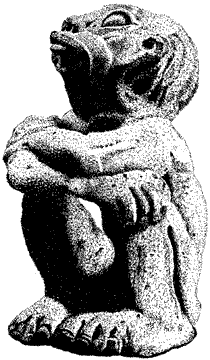
| Seated fetus effigy with arms clutching knees, from Catemaco, Veracruz area. Basalt. Department of Anthropology, Smithsonian Institution. Drawing: G. Bendersky |
|
In contrast, most adult stone figurines exhibit stylized shapes for the limbs, little attention to definition of bony or muscular protrusions, and an idealized face. The fact that the Olmecs used a greater degree of naturalism in their portrayal of fetuses than when depicting adults is puzzling; perhaps their intention was to describe in a very precise manner a stage of human development rarely seen.
In addition to their naturalistic features and proportions, several of the figures possess specific details of anatomy found in fetuses. One feature that may be portrayed is cutaneous pellucidity. Between 15-25 weeks, veins can be seen beneath the skin. One sculpture under study is fashioned from a light greenish-gray albitite which seems to have a waxy, or translucent, surface or skin. On the top of the head and down the back are finely incised lines that appear to suggest this stage of visibility of the veins beneath the fetus's skin. In terms of specific abnormalities portrayed in the fetus sculptures, agnathia or micronathia (chinlessless) is the most obvious. Since fetuses normally have a large head relative to the body, all the images have relatively large heads; however, macrocephaly is probably depicted in several pieces. These abnormalities may be symptomatic of the congenital anomalies that led to the premature births and deaths of the fetuses. |
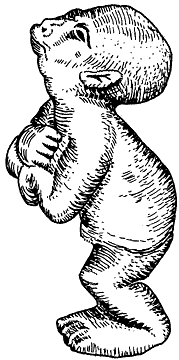
| Agnathic fetus effigy from Guerrero. Stone. National Museum of Anthropology, Mexico. Drawing: C. Tate. |
|
Despite the fact that some exhibit congenital abnormalities, the overall attitude of the figures is one of vitality. The fetus effigies are not recumbent or helpless, as one would expect of a newborn. Instead, they are animated, taking positions they could achieve while in the womb. Thus, in terms of their proportions, detailed anatomical features, and poses, fetus sculptures are the most naturalistic images among Olmec stone figurines.
Some of the fetus effigies have hair, nails, pierced ears or adornments. These natural features do correlate with fetal development, in which fingernails are present at 24 weeks, the eyes are open and hair is well developed at 28, and toenails are present at 30 weeks. The pierced ears, earspools, incised iconography, and sacks carried by some fetuses are clearly not natural but cultural items, probably added by the sculptors to illustrate the significance of the fetus's ritual roles. Pierced ears and earspools indicate high status in Mesoamerican culture. Several effigies wear a helmet. The three highly eroded monumental fetuses at La Venta also wear helmets. Similar helmets are worn by the well-known colossal heads thought to depict Olmec rulers, possibly in their role as ritual ballplayers. Two of the effigies are incised with the pelt and head tufts of a character in Olmec iconography, the so-called Dragon. The Olmecs created this symbol to give form to the powers inherent in the sky and earth. As a cosmic symbol, the Olmec Dragon was associated with shamans. A final cultural attribute of the sculptures is a fiber sack carried on the back of two of the fetuses. Shown above the sack are its contents: a maize seed. All these features - specific headgear, earspools, the Olmec Dragon and by extension the Olmec cosmos and maize - are associated with Olmec shamanic rulers and therefore provide the fetal figures with a political-religious status. Our use of the term "Olmec" refers to the various peoples in southern Mexico and Central America, who, between about 1200-400 B.C., produced skillfully crafted objects that conformed to a coherent system of subject matter, sculptural format, and formal qualities. These ancient peoples did not all speak the same language but communicated certain ideas by trading culturally valuable items, especially sculpture. This trade was especially intense during the Middle Formative Period, about 900-600 B.C., during which the fetus effigies were likely produced. Despite the fact that the Olmec of the Gulf Coast were the earliest makers of monumental stone sculpture in the Americas, they have been discovered only in the last century. Therefore, most scholars are unaware of the broad range of intellectually sophisticated subjects in the Olmec artistic tradition. Another reason the fetuses have not been identified until now is that the small-scale stone sculptures have drawn less attention than the impressive monumental stone sculptures. These take the form of colossal heads and enormous thrones, stelae, and 3-D figures. Among stone figurines, the fetus is one of a limited number of human subjects. The Olmecs portrayed the normally developed adult human figure in only four positions (with some variations): standing meditation, seated meditation, shamanic transformation into an animal state, and yogic contortion. The only other categories for the human figure in small-scale stone sculpture are hunchbacks, dwarfs, and the much more numerous examples of the fetus. Taken together, the types of Olmec figurines apparently form a primer of "corporeal facts" about their ritual practices and reveal shared physical, political, and spiritual human experiences. |
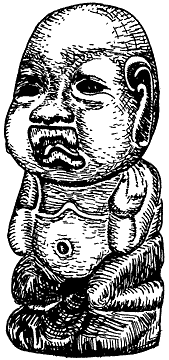
| Fetus effigy with pierced ears, holding head, from Alta Verapaz, Guatemala. Black stone; H: 25 cm. Museum of the American Indian, Smithsonian Institution. Drawing: C.Tate. |
|
The context in which the fetus effigies were used, or at least finally deposited, provides an important clue to their significance. This is especially valuable information in the absence of written texts. The only small-scale fetus effigy that has been recovered archaeologically was found at La Venta, Tabasco, Mexico. There, 30 figurines were among the thousands of crafted, semi-precious stone objects deposited in spatially significant arrays below the surface of the ceremonial courtyards. This fetus effigy was cached with three other figurines, two of which depicted children and one a dwarf, near what appeared to be a burial of a small child. This cache was located on the central axis of the site. Perhaps this was La Venta's manner of memorializing the birth and death of perinatals or infants of important lineage.
The largest scale fetus sculptures in Olmec art are the three placed on Structure D-7 at the south end of La Venta's approximately north-south axis. The first Euro-American explorers of La Venta discovered these 34-ton blocks in 1925 but did not recognize that they were carved. The three sandstone sculptures, each about 7 feet tall, represent a human figure with deeply flexed legs and arms upstretched to support a very large head, possibly helmeted. Archaeologist Rebecca González Lauck of the Instituto Nacional de Antropología e Historia de México, in charge of the current excavation of La Venta, notes that "...[t]he location and position of this sculptural group seems to reflect that of the three colossal heads that Stirling (1940) discovered in the northern part of the zone. In both cases, the sculptures mark the principal area of the city, perhaps signaling the main entrances." Since the spatial placement of sculpture at La Venta seems to have been an important aspect of its significance, it might be that a ritual procession, starting from the three fetuses in the south through the major portion of the site to the three colossal heads in the north, created a narrative of growth and transformation of kings from fetus to ancestor. There is one more bit of evidence regarding the fate of actual fetuses in Olmec times. Investigations at the site of El Manatí, Veracruz, reveal that about 1200 B.C., a ritual deposit of at least 37 wooden busts of idealized human figures was placed into fresh and saltwater springs at the foot of a hill. Cached with certain wooden busts were jade celts; with others, stone scepters; with others, small piles of stones precious to the Olmec; and scattered over some were the disarticulated femurs and skulls of several newborns or fetuses. One wooden bust covered a complete primary burial of a neonate or fetus. The fetuses could have been taken from women who died during pregnancy or in childbirth. Alternatively, since some of the skulls showed signs of cuts, it is possible that at least those infants had been sacrificed. The issue of infanticide is still unresolved although monumental sculptures of adults holding limp babies are highly suggestive of this practice. Now I'd like to focus on what modern Mesoamerican peoples have said about fetuses and about maize, which seems to me to be conceptually related. Contemporary Maya Tzeltal peoples have noted the non-human appearance of the embryo, observing that the miniscule, tailed being looks like a tadpole or baby rat. This embryonic stage of development may be represented in ancient Olmec art by their jade "spoons," which have been interpreted previously as representing tadpoles. From the 9th to the 12th week, human features develop and the proportions change from nearly 1:2 to a 1:3 ratio of head to body. Thus, while the Olmec shaman engaged in the mystical conversion of his human body to a zoomorph, every human fetus appears to undergo a similar but reverse pattern of metamorphosis. It is tempting to conclude that the Olmec shaman may have identified the embryonic human resemblances to reptile or rodent species with the principle of Olmec spiritual transformation. This suggests a reciprocal form of the 18th-19th century AD Euro-American concept that ontogeny recapitulates phylogeny. Accordingly, the function of the embryo and fetus in Olmec art may have been to represent the observation that humans begin as animals, while other sculptures represent the reverse transformation of humans back to animals. These kinds of parallels are fundamental to the expression of abstract concepts in Mesoamerican thought and art. Most Mesoamerican peoples consider human beings to be like the maize plant. The Mayan creation story told in the 16th century Quiché book "Popol Vuh" states that the present race of humans was made from corn dough. The Divine Grandmother ground the corn and mixed it with the water with which she rinsed her hands. After she shaped the dough, it became the human body and the water became human blood. All Mesoamerican cultures considered humans and maize as functionally synonymous. We propose that the developmental cycles of humans and maize were also considered parallel. In Mesoamerica, the human gestation cycle and the life cycle of maize are both socially constructed to be 260 days. This is also the number of days in the supremely important "ritual" calendar. The 260-day calendar is divided into 13 cycles of 20 distinctly named days. Contemporary Mayan Tzeltal speakers divide the maize cycle into 20-day periods, during which they perform specific activities related to maize agriculture. In the first 20-day period, the Tzeltal Maya prepare the earth; the second is for planting. In the third, they anticipate rain to germinate the maize. In the fourth 20-day period, the sun warms the soil. In the fifth, roots develop indicating the seed is fertile, and in the sixth, the spirit of maize enters. Interestingly, at this point, or about 14-17 weeks by our count, the quickening of the fetus in the womb is known to occur although it is often later. In the seventh 20-day period, kernels appear in a housing and the immature ear is said to "wake up". In the eighth, the immature edible ear, jilote, forms and can be picked for food, and in the ninth, the jilote matures and there is a first fruits celebration. In the tenth (at 25 1/2 to 28 1/2 weeks), the maize plant stops growing as its fruit is mature, the silk darkens, dries, and dies, and the principal ear is picked. At this point in the development of the fetus, a premature infant has a chance of living. The last three 20-day periods of the maize cycle involve the ripening and harvest of the corn and the drying of seed for next year's crop. As the Maya constructed the process of maize growth, they included all related activities so that it would occupy a full 260-day gestation period. This socially constructed parallelism between the rapid growth and transformation of human fetuses and maize helps explain the maize seeds and seed sacks incised on two of the fetus sculptures. It is widely recognized that maize iconography, primarily in the form of sprouting plants, frequently appears in Olmec art. Maize seeds appear incised on jade celts (which themselves represent maize), emerging from the cleft heads of Olmec "supernaturals," and on the headbands of rulers. Thus the selection by the Olmec of the sprout of maize as its principal symbol and their emphasis on the "sprout-phase" or fetus of a human points to a particular fascination with the developmental stages of life, in which the most dramatic and rapid transmutation occurs. The questions remain as to what the Formative Period Mesoamericans intended to symbolize with the fetus sculptures. Were they used as "milagros" - as visual prayers for a successful birth? If so, why did some of the fetuses have deformities? Did they memorialize particular individuals, or serve as repositories for their spiritual essences as did other Mesoamerican sculptures? Were they substituted for live offerings in sacrificial caches and burials? Were they used by this early agricultural society as sympathetic magic to encourage formation of viable crops of maize? As new souls, were fetuses seen as messengers from the other world? Or did a fetus effigy serve as a powerful symbol of the physical and spiritual transformative capacity of the human being? If so, how was this drama played out? In contrast with a Euro-American notion of the static nature of human existence, most Olmec stone figurines represent humans in a state of physical or spiritual transformation. The metamorphosis evident in the developing fetus, from a tadpole or fish-like form to a human one, makes it a potent symbol for such a process. In fact, among the Mixe, contemporary descendants of the Olmecs, the female supernatural power that controls bodies of water also controls human childbirth and fishing. It is as if one "fishes" for children, or as if fish were placed in the womb in order to be "cooked" into human infants, as the Mixe say. Similarly, the fetus parallels the life cycle of maize, the quintessential Mesoamerican symbol of the miracle of life. Both undergo dramatic transformation, the fetus apparently from "lower" to "higher" animal and the maize from seed to gloriously upright fruiting plant to seed again.
Why has the fetus not been a symbol of transformation in any other society? Have most human cultures been uncomfortable with the non-human appearance of a human embryo? Does the family's grief at the death of its potential infant preclude the desire to learn about the development of the young being? Is such a death considered sinful, or dangerous to the mother or family, or is the fetus considered too sacred for scrutiny? This apparently widespread human avoidance of studying the spontaneously or deliberately aborted fetus seems to point to the concept that being human is ideally a static state, subject to growth and decay but not to radical shifts in form. Euro-American avoidance of the fetus has changed recently with the advent of sonograms. Now people proudly exhibit pre-birth photos of their babies. These images have made their way into art as well. Conversely, in Mesoamerica, the most deeply rooted certainty was that life involves transformation. Humans were believed to be born with animal spirit companions. Spiritually adept persons could metamorphose into their animal alter-ego. The concept of self was frequently extended to the impersonation of a supernatural in ritual circumstances. In every community, offerings to the ancestors in the form of food and flowers transformed into the fluid essences of scent to nourish the watchful spirits. It seems to me that the Olmec focus on transformations of their bodies and their consciousness into alternate states enabled them to honor the capacity for shape-shifting in the human fetus, while Western cultures spurned it. (A fuller version of the article appeared in Perspectives in Biology and Medicine, Spring 1999, pp. 1 - 20.)
BENSON, E.P., et. al. eds., Olmec Art of Ancient Mexico. Washington, D.C.: National Gallery of Art, 1996. CHOULANT, A.L., The History and Bibliography of Anatomical Illustration. Chicago: U. of Chicago, 1920. CLAYTON, M., Leonardo da Vinci: The Anatomy of Man. London: Bullfinch Press, 1992. COE, M.D., et. al., The Olmec World: Ritual and Rulership. New York and Princeton: The Art Museum, 1995. DRUCKER, P., La Venta, Tabasco: A Study of Olmec Ceramics and Art. Bureau of American Ethnology Bull. 157. Washington, D.C.: Smithsonian Institution, 1955. FIELDS, V.M., The Iconographic Heritage of the Maya Jester God. In Sixth Palenque Round Table, 1986, edited by V.M. Fields. Norman: U. of Oklahoma P, 1991. LIPP, F.J., The Mixe of Oaxaca: Religion, Ritual and Healing. Austin: U of Texas P, 1991. LYONS, A.S., and PETRUCELLI II, R.J., Medicine: An Illustrated History. New York: Abradale P, 1987. MOORE, K.L., The Developing Human: Clinically Oriented Embryology. 2nd ed. Philadelphia: W.B. Saunders, 1977. ORTIZ CEBALLOS, P., and RODRIGUEZ, M.C., El Manati un espacio sagrado. Xalapa, Veracruz: Universidad Veracruzana, 1994. REILLY, III, F.K., The Shaman in Transformation Pose: A study of the Theme of Rulership in Olmec art. Record Art Museum, Princeton Univ. 48(2): 4-21, 1989. STROSS, B., Aspects of Language Acquisition by Tzeltal Children. Ph.D. Diss., Dept. of Anthropology, U of California, Berkeley, 1969. STROSS, B., Maize and fish: The Iconography of Power in Late Formative Mesoamerica. Res. Anthropol. Aesth. 25:10-35, 1994. TATE, C.E., The Shaman's Stance: Integration of Body, Spirit and Cosmos in Olmec Sculpture. In Eighth Palenque Round Table, 1993, edited by M.J. Macri and J. McHargue. San Francisco: Pre-Columbian Art Research Institute, 1996. TATE, C.E., La Venta's Stone Figurines and the Olmec Body Politic. In Memorias del Tercer Simposio Internacional de Mayanistas. Mexico: Institution de Investigaciones Filologicas, Universidad Nacional Autonoma de Mexico, 1998. |